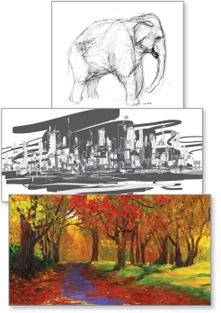222
Understanding the Elements
of Visual Art
Developing an understanding of the elements of visual art will provide you with the vocabulary for analyzing and discussing images and graphics. Common elements of visual art are discussed here:

- Lines create boundaries and influence meaning. Soft lines create a dreamlike effect and may indicate elegance and beauty. Sharp, heavy lines stand out and may create tension.
- Shapes enclose two-dimensional spaces. They may be geometrical, like a circle or a square, or free flowing and irregular, like a leaf or a seashell.
- Value in relation to visual art is the relative lightness and darkness of a visual. The contrast between light and dark creates meaning. Lighter images tend to appear closer to the viewer, while darker images appear farther away.
- Colors work together in special ways to describe an object, convey emotion, and symbolize meaning. (See page 224 for a closer look at colors.)
- Space creates depth and perspective. It includes the background, the middle ground, and the foreground.

- Texture refers to the quality of a surface and appeals to our sense of touch. Texture may be real or implied.
Your Turn Find a painting or an illustration that interests you. In a paragraph, analyze the image’s elements, which are discussed above.


